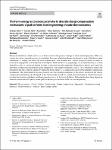Item Infomation
Full metadata record
| DC Field | Value | Language |
|---|---|---|
| dc.contributor.author | Klein, Andreas | - |
| dc.contributor.author | Albe, Karsten | - |
| dc.contributor.author | Bein, Nicole | - |
| dc.date.accessioned | 2023-08-25T09:42:52Z | - |
| dc.date.available | 2023-08-25T09:42:52Z | - |
| dc.date.issued | 2023 | - |
| dc.identifier.uri | https://link.springer.com/article/10.1007/s10832-023-00324-y | - |
| dc.identifier.uri | https://dlib.phenikaa-uni.edu.vn/handle/PNK/8964 | - |
| dc.description | CC-BY | vi |
| dc.description.abstract | Chemical substitution, which can be iso- or heterovalent, is the primary strategy to tailor material properties. There are various ways how a material can react to substitution. Isovalent substitution changes the density of states while heterovalent substitution, i.e. doping, can induce electronic compensation, ionic compensation, valence changes of cations or anions, or result in the segregation or neutralization of the dopant. While all these can, in principle, occur simultaneously, it is often desirable to select a certain mechanism in order to determine material properties. Being able to predict and control the individual compensation mechanism should therefore be a key target of materials science. This contribution outlines the perspective that this could be achieved by taking the Fermi energy as a common descriptor for the different compensation mechanisms. | vi |
| dc.language.iso | en | vi |
| dc.publisher | Springer | vi |
| dc.subject | Fermi energy | vi |
| dc.subject | oxide electroceramics | vi |
| dc.title | The Fermi energy as common parameter to describe charge compensation mechanisms: A path to Fermi level engineering of oxide electroceramics | vi |
| dc.type | Book | vi |
| Appears in Collections | ||
| OER - Khoa học Vật liệu, Ứng dụng | ||
Files in This Item:

